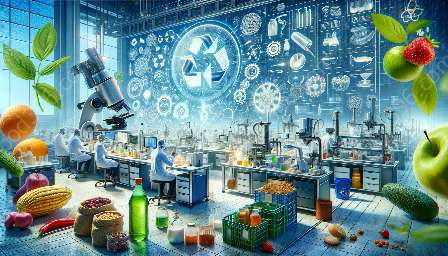Food spoilage is a natural process that occurs when food deteriorates in quality and becomes unsafe for consumption. Food preservation, on the other hand, involves the use of various techniques to prolong the shelf life of food, maintaining its safety and quality. This topic cluster delves into the fascinating world of food spoilage and preservation, integrating insights from food microbiology, food science, and technology.
The Science of Food Spoilage
Food spoilage is primarily driven by the activities of microorganisms, enzymes, and environmental factors. Understanding the microbiological aspects of food spoilage is crucial for identifying the causes and preventing it. Food microbiology examines the complex interactions between food and microorganisms, shedding light on how these microorganisms can lead to spoilage. Factors such as temperature, moisture, pH, and oxygen availability play a significant role in determining the rate of food spoilage.
Microorganisms Responsible for Food Spoilage
Microorganisms, including bacteria, yeasts, and molds, are the primary culprits behind food spoilage. Bacteria can cause food to spoil through processes such as decomposition, fermentation, and the production of toxins. Yeasts and molds can lead to physical changes in food, such as discoloration, off-flavors, and mold growth. By understanding the behavior and characteristics of these microorganisms, food scientists can develop effective preservation methods to hinder their growth and preserve food quality.
Methods of Food Preservation
Food preservation techniques aim to inhibit or delay the growth of spoilage-causing microorganisms, thereby extending the shelf life of food. These methods can be categorized into physical, chemical, and biological preservation techniques, each offering unique benefits and considerations. Understanding these methods is essential for maintaining food safety and preventing spoilage.
Physical Preservation Techniques
Physical preservation methods involve controlling environmental conditions or using physical barriers to prevent spoilage. Examples include refrigeration, freezing, drying, and packaging. Refrigeration and freezing inhibit the growth of microorganisms by reducing the temperature and slowing down enzymatic reactions, while drying removes moisture to prevent microbial growth. Proper packaging creates a barrier between the food and the external environment, protecting it from contamination.
Chemical Preservation Techniques
Chemical preservation utilizes various compounds such as salt, sugar, vinegar, and food additives to inhibit microbial growth and preserve food. These compounds create an unfavorable environment for microorganisms, preventing spoilage. Additionally, food additives such as antioxidants and preservatives can prolong the shelf life of processed foods by delaying lipid oxidation and microbial spoilage. Understanding the proper use and regulation of chemical preservatives is vital for ensuring food safety and quality.
Biological Preservation Techniques
Biological preservation involves the use of beneficial microorganisms or enzymes to prevent the growth of spoilage-causing microbes. Fermentation, for example, utilizes lactic acid bacteria to convert sugars into acids, creating an acidic environment that inhibits the growth of harmful microorganisms. Similarly, the use of bacteriophages, which are viruses that target specific bacteria, can be employed to control bacterial spoilage in food products.
The Importance of Food Safety
Maintaining food safety is paramount in the context of food spoilage and preservation. By applying knowledge from food microbiology and science, food technologists and industry professionals can implement rigorous safety measures to protect consumers from foodborne illnesses and ensure the longevity of food products. Understanding the intricacies of food safety regulations and best practices is essential for professionals in the food science and technology field.
Modern Technologies in Food Preservation
Advancements in food science and technology have led to the development of innovative preservation methods aimed at enhancing the safety and longevity of food products. Techniques such as high-pressure processing, pulsed electric field processing, and irradiation offer novel approaches to preserving food while maintaining its nutritional value and sensory attributes. These modern technologies leverage scientific principles to combat food spoilage and meet the evolving demands of the food industry.
Conclusion
Food spoilage and preservation are multifaceted topics that intersect with food microbiology, food science, and technology. By gaining a deeper understanding of the microbial, chemical, and physical aspects of spoilage and preservation, individuals within the food industry can contribute to the development of safe, high-quality food products. This topic cluster serves as a comprehensive guide to the science behind food spoilage and preservation, highlighting the importance of leveraging knowledge from food microbiology and technological innovations to mitigate spoilage and ensure food safety.

